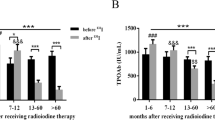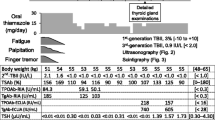Abstract
Radioiodine treatment use is frequent in patients with benign hyperfunctioning thyroid diseases and the side-effects are rare. In this paper we described the appearance of TSH-receptor antibodies and the concomitant development of persistent hyperthyroidism in a patient with hyperfunctioning thyroid adenoma after 131I treatment. A 70-year-old man presented a hyperfunctioning thyroid adenoma with suppressed uptake in the adjacent normal gland. Antibodies against the thyroglobulin (TgAb), thyroid peroxidase (TPOAb) and TSH-receptor (TRAb) were absent. One year after remission by radioiodine therapy the patient developed severe and persistent hyperthyroidism associated with diffuse 131I uptake in the gland. TgAb and TPOAb remained absent, but TRAb were present. Although spontaneous development of Graves’ disease cannot be excluded, the time sequence and the negative familial and personal history for autoimmune diseases suggest a possible connection between the two phenomena. The release of TSH-receptor antigen from follicular cells damaged by 131I may have triggered the autoimmune response turning a toxic nodular goiter patient into a Graves’ disease patient.
Similar content being viewed by others
References
McGregor A.M., Petersen M.M., Capiferri R., Evered D.C., Smith B.R., Hall R. Effects of radioiodine on thyrotropin binding inhibiting immunoglobulins in Graves’ disease. Clin. Endocrinol. 11: 437, 1979.
Weetman A.P., McGregor A.M. Autoimmune thyroid disease: development in our understanding. Endocr. Rev. 5: 309, 1984.
McGregor A.M., McLachlan S.M., Smith B.R., Hall R. Effect of irradiation on thyroid-autoantibody production. Lancet 2: 442, 1979.
Feldt-Rasmussen U., Bech K., Date J., Petersen P.H., Johansen K., Madsen S.N. Thyroid stimulating antibodies, thyroglobulin antibodies and serum proteins during antithyroid treatment with radioiodine or propyltiouracil of Graves’ disease. Allergy 32: 161, 1982.
Walfish P.G., Caplan D., Rosen I.D. Post-parathyroidectomy transient thyrotoxicosis. J. Clin. Endocrinol. Metab. 75: 224, 1992.
Werner S.C. Graves’ disease following acute (subacute) thyroiditis. Arch. Intern. Med. 139: 1313, 1979.
Monzani F., Caraccio N., Goletti O., Lippolis P.V., Casolaro A., Del Guerra P., Cavina E., Miccoli P. Five-year follow-up of percutaneous ethanol injection for the treatment of hyperfunctioning thyroid nodule: a study of 117 patients. Clin. Endocrinol. (Oxf.) 46: 9, 1997.
Monzani F., Del Guerra P, Caraccio N., Casolaro A., Lippolis P. V., Goletti O. Appearance of Graves’ disease after percutaneous ethanol injection for the treatment of hyperfunctioning thyroid adenoma. J. Endocrinol. Invest. 20: 294, 1997.
Smyth P.P.A., Neylan D., MacMullan N.M., Smith D.F., McKenna T.J. Sequential presentation of a case of hyperthyroidism with autonomously functioning nodules and Graves’ disease in the presence of IgG thyroid stimulators. Acta Endocrinol. (Copenh.) 118: 474, 1988.
Boddemberg B., Voth E., Schicha H. Immunogene Hyperthyreose nach radiojod-Ablation einer fokalen Autonomie. Nuclearmedizin 32: 18, 1993.
Chiovato L., Santini F., Vitti P., Bendinelli G., Pinchera A. Appearance of thyroid stimulating antibody and Graves’ disease after radioiodine therapy for toxic nodule. Clin. Endocrinol. (Oxf.) 40: 803, 1994.
David E., Rosen I.B., Bain J., James J., Kirsh J.C. Management of the hot thyroid nodule. Am. J. Surg. 170: 481, 1995.
Nygaard B., Faber J., Veje A., Hegedus L., Hansen J.M. Appearance of Graves’-like disease after radioiodine for toxic as well as non-toxic multinodular goitre. Clin. Endocrinol. (Oxf.) 43: 129, 1995.
Kay T.W.H., Heyma P., Harrison L.C., Martin F.I.R. Graves’ disease induced by radioactive iodine. Ann. Intern. Med. 107: 857, 1987.
Nygaard B., Knudsen J.K., Hegedus L., Scient A.V.C., Hansen J.E.M. Thyrotropin receptor antibodies and Graves’ disease, a side-effect of 131I treatment in patients with non nontoxic goiter. J. Clin. Endocrinol. Metab. 82: 2928, 1997.
Huysmans D.A.K.C., Hermus A.R.M.M., Edelbroek M.A.L., Tjabbes T., Oostdijk A., Ross H.A., Corstens F.H.M., Kloppenborg P.W.C. Autoimmune hyperthyroidism occurring late after radioiodine treatment for volume reduction of large multinodular goiter. Thyroid 7: 535, 1997.
Brun J., Block U., Ruf G., Bos I., Kunze W.P., Scriba P.C. Volumetrie der Schilddrusenlappen mittels Real-Time Sonographie. Dtsch. Med. Wochenschr. 106: 1338, 1981.
Studer H., Gerber H., Peter H.J. Multinodular goiter. In: DeGroot L.J., (Ed.), Endocrinology. W.B. Saunders, Philadelphia, 1989, p. 722.
Beck K. Immunological aspects of Graves’ disease and importance of thyroid stimulating immunoglobulins. Acta Endocrinol. (Copenh.) 254 (Suppl.): 1, 1983.
Author information
Authors and Affiliations
Rights and permissions
About this article
Cite this article
Regalbuto, C., Salamone, S., Scollo, C. et al. Appearance of anti TSH-receptor antibodies and clinical Graves’ disease after radioiodine therapy for hyperfunctioning thyroid adenoma. J Endocrinol Invest 22, 147–150 (1999). https://doi.org/10.1007/BF03350896
Accepted:
Published:
Issue Date:
DOI: https://doi.org/10.1007/BF03350896




